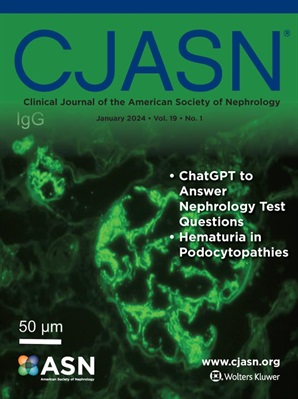高热暴露与慢性肾病患者的医疗使用情况
IF 8.5
1区 医学
Q1 UROLOGY & NEPHROLOGY
Clinical Journal of the American Society of Nephrology
Pub Date : 2025-04-04
DOI:10.2215/cjn.0000000699
引用次数: 0
摘要
我们调查了慢性肾脏疾病(CKD)患者体温与保健利用的关系。我们利用具有个体和年份固定效应的面板回归模型来评估2015年10月1日至2023年3月31日期间暴露于不同温度水平(由热指数测量)与每周医疗保健利用率变化的关系。数据来源于医疗索赔数据、独立坡度模型参数海拔回归(PRISM)气候数据和每个个体的人口普查块组。研究人群包括916,886名有商业或医疗保险的人,他们被诊断为CKD G3、G4或G5期。CKD的定义使用医疗声明中的诊断代码和估计的肾小球滤过率(eGFR)实验室结果。暴露量是指一周中每天在华氏10度的箱子里保持热指数的天数。结果:我们发现,与60-70F相比,暴露于更高的热指数箱(90-100F)与每周急诊科使用率增加有关(0.55%;95% ci: 0.42%-0.68%;p<0.001),与热相关的初级诊断代码的急诊科就诊增加的百分比更大(2.07%;95% ci: 1.63%-2.51%;P <0.001)或肾脏相关的初步诊断代码(1.37%;95% ci: 0.56%-2.17%;p < 0.001)。初级诊断代码与肾脏疾病相关的ED就诊对最不可能使用空调的患者的影响更大(2.48%;95% ci: 0.84%-4.13%;p < 0.01)。比较80-90华氏度和60-70华氏度的热指数,观察到较小的、有统计学意义的结果。结论:暴露于热指数高于90度的环境中,每周ED使用率更高,ED使用率与热或肾脏相关的初级诊断代码相关。版权所有©2025 by美国肾脏学会…本文章由计算机程序翻译,如有差异,请以英文原文为准。
High Heat Exposure and Medical Utilization among the Chronic Kidney Disease Population
We investigated the relationship between temperature and healthcare utilization among patients with chronic kidney disease (CKD). We utilized panel regression models with individual and year fixed effects to evaluate how exposure to different levels of temperature (measured by heat index) was associated with changes in weekly healthcare utilization from October 1, 2015, to March 31, 2023. Data were derived from medical claims data, Parameter-Elevation Regressions on Independent Slopes Model (PRISM) climate data, and the Census block group of each individual. The study population was comprised of 916,886 individuals with commercial or Medicare insurance who had been diagnosed with CKD stage G3, G4, or G5. CKD was defined using diagnosis codes in medical claims and estimated glomerular filtration rate (eGFR) laboratory results. Exposure was the number of days in a week with a daily heat index in ten-degree Fahrenheit bins. Results: We found that exposure to a higher heat index bin, 90-100F compared to 60-70F, was associated with an increase in weekly emergency department utilization (0.55%; 95% CI: 0.42%-0.68%; p<0.001), with larger percent increases for ED visits with a heat-related primary diagnosis code (2.07%; 95% CI: 1.63%-2.51%; p<0.001) or a kidney-related primary diagnosis code (1.37%; 95% CI: 0.56%-2.17%; p <0.001). ED visits with a primary diagnosis code related to kidney disease were associated with a larger impact among those least likely to have access to air conditioning (2.48%; 95% CI: 0.84%-4.13%; p<0.01). Smaller, statistically significant results were observed comparing heat indexes of 80-90F to 60-70F. Conclusions: Exposure to heat indexes above 90 degrees was associated with greater weekly ED utilization and ED utilization with heat- or kidney-related primary diagnosis codes. Copyright © 2025 by the American Society of Nephrology...
求助全文
通过发布文献求助,成功后即可免费获取论文全文。
去求助
来源期刊
CiteScore
12.20
自引率
3.10%
发文量
514
审稿时长
3-6 weeks
期刊介绍:
The Clinical Journal of the American Society of Nephrology strives to establish itself as the foremost authority in communicating and influencing advances in clinical nephrology by (1) swiftly and effectively disseminating pivotal developments in clinical and translational research in nephrology, encompassing innovations in research methods and care delivery; (2) providing context for these advances in relation to future research directions and patient care; and (3) becoming a key voice on issues with potential implications for the clinical practice of nephrology, particularly within the United States. Original manuscript topics cover a range of areas, including Acid/Base and Electrolyte Disorders, Acute Kidney Injury and ICU Nephrology, Chronic Kidney Disease, Clinical Nephrology, Cystic Kidney Disease, Diabetes and the Kidney, Genetics, Geriatric and Palliative Nephrology, Glomerular and Tubulointerstitial Diseases, Hypertension, Maintenance Dialysis, Mineral Metabolism, Nephrolithiasis, and Transplantation.

 求助内容:
求助内容: 应助结果提醒方式:
应助结果提醒方式:


